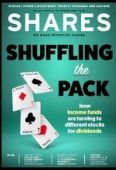Archived article
Please note that tax, investment, pension and ISA rules can change and the information and any views contained in this article may now be inaccurate.
Price to book can be a good way to value banks and housebuilders

There are different ways to value companies such as price to earnings and price to earnings growth. Particularly popular among value investors is the price to book metric, enabling individuals to screen for companies trading on a discount to the value of their assets.
It has historically been the preferred way in which to value banks, insurers, property companies, housebuilders and investment trusts.
At the simplest level, a company is worth the value of its assets minus its liabilities – its book value.
Examples of book values
• PROPERTY COMPANY
The book value of a property company is how much its collection of offices or other property is worth, minus
any debt.
• INSURANCE COMPANY
An insurer will collect customer premiums and invest them in various assets. It will then use these assets and any investment gains to fund any customer claims. Therefore, its book value is principally its investment portfolio minus any liabilities.
Book value is the amount of money that would be available to shareholders if the company’s assets were sold at their balance sheet value and all liabilities were paid off.
For example, if assets equal £100m while liabilities are £60m then the company’s book value is £40m.
Book value, also known as net asset value, is often expressed in per share terms, or book value divided by the number of shares in issue.
The market price per share is compared to the book value per share, a figure called the price to book ratio. This is worked out by dividing the share price by the book value per share.
ROLE IN TAKEOVERS
This valuation method is often a first point of call when looking for takeover targets. If the market value of a company, or its share price, is lower than its book value, or book value per share then, in theory, a buyer could take control and sell the company’s assets for more than it paid. This was a key theme during the heyday of the asset-strippers in 1970s and 1980s.
Investors and analysts use this comparison to differentiate between the true value of a publicly traded company and investor speculation.
As a rule of thumb, investors will infer a price to book of less than one to indicate that a stock is undervalued, while a ratio of greater than one may indicate that a stock is overvalued.
Why do companies trade below book value?
• Illiquid assets – i.e. they may not be easy to sell quickly
• The assets may be difficult to value
• The assets may be overvalued
• Concerns among investors that the assets are falling in value
• The assets aren’t generating a good return
• Selling the assets would create a tax liability
DOWNSIDES TO CONSIDER
A major drawback with book value is that it is not always easy to establish the value of a company’s assets accurately.
It may be unrealistic to assume that the value of an asset on the balance sheet is equivalent to the value it would fetch if it were to be sold off. It may be that an asset is no longer as useful to the business as it used to be, such as an old factory.
Equally, the value of an asset acquired in the past may have significantly increased. Property companies are a good example, where land and buildings typically sit on a balance sheet at cost yet years later may be worth substantially more, especially when property is often revalued only periodically.
RISE OF INTANGIBLE ASSETS
Things like land, property, machinery and furniture are called tangible assets. In other words, they can be seen and touched.
Intangible assets include potentially valuable entities like software, apps, brand names, corporate reputation and much else including goodwill on acquisitions. The latter effectively reflects the premium paid by an acquirer to complete most deals.
These types of assets are often tricky to value accurately and it is not unusual for companies with lots of intangible assets to trade on high price to book ratios.
For example, many technology companies can trade at a price to book of 10 or more, while banks will mostly trade around 1 or less. The difference is down to how an industry uses capital to generate earnings.
Let’s take Microsoft as an example. Its key costs are staff, and the company’s business model is not capital intensive.
On the other hand, banks require a lot of capital, such as bank deposits, bonds and so on. Because banks tend to hold relatively liquid assets on their balance sheets, these assets can be valued at their fair market value.
This means that a bank’s balance sheet, or the price to book, should in theory be roughly equal to the fair market value of its assets. That implies a price to book ratio of 1, yet many banks trade below this level when investors are worried about the state of the economy and interest rates being low for a long time. In comparison, Microsoft currently trades on 12-month forward price to book ratio of 11.1, according to Refinitiv data.
Investors often prefer to use price to sales or EV/EBITDA (enterprise value to earnings before interest, tax, depreciation and amortisation) when valuing software companies.
Important information:
These articles are provided by Shares magazine which is published by AJ Bell Media, a part of AJ Bell. Shares is not written by AJ Bell.
Shares is provided for your general information and use and is not a personal recommendation to invest. It is not intended to be relied upon by you in making or not making any investment decisions. The investments referred to in these articles will not be suitable for all investors. If in doubt please seek appropriate independent financial advice.
Investors acting on the information in these articles do so at their own risk and AJ Bell Media and its staff do not accept liability for losses suffered by investors as a result of their investment decisions.
Issue contents
Editor's View
Exchange-Traded Funds
Feature
First-time Investor
Great Ideas
Money Matters
News
- Regulators on both sides of the pond size up big tech targets
- AIM index regains strength and US tech stocks rally again
- Leisure sector hit by Boris’ latest lockdown restrictions
- Vodafone could raise stakes in TalkTalk buyout battle
- Hipgnosis rival Round Hill Music to float new trust on UK stock market
- Forget tech, solar and clean energy is the hot sector in 2020

 magazine
magazine









